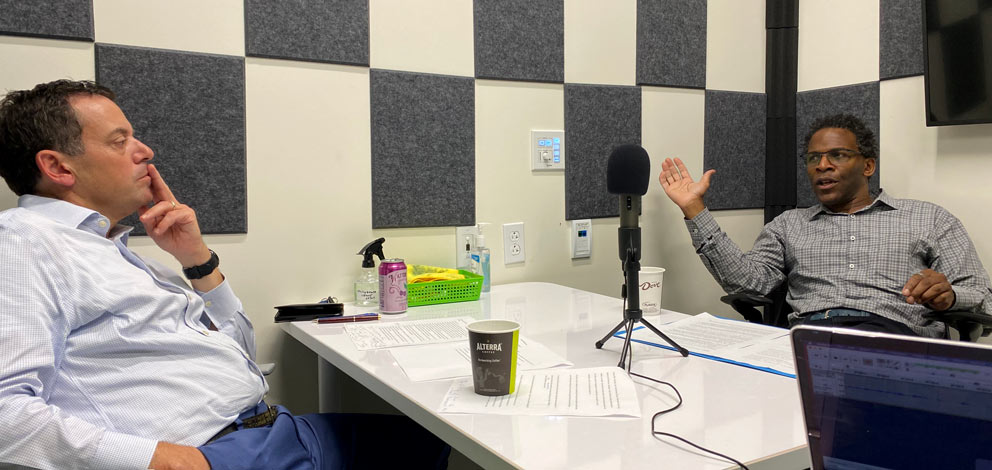
Proposing Collaboration as a Key Principle of the Liberal Arts by Brian T. Edwards
Originally published in the Summer 2022 School of Liberal Arts Magazine
Monday, August 15th, 2022
It may seem surprising to propose collaboration as a key value of a liberal arts education. Much of what we seem to focus on in higher ed is built around developing the individual. If you are a student, you are well aware of the way college is organized around your personal responsibilities: you do the reading, you write the papers, and you take the exams. Most professors want you to be able to show that you know the material on your own and that you can produce arguments or research independently. Try to “collaborate” on your papers or your midterms and you’ll find yourself in front of the honor board.
It starts long before you get to college, of course, from the building of personal resumes back in high school to the rigors of the college application process. Highly selective colleges proudly tout their acceptance rate, a stomach-clenching number that pits you alone against tens of thousands of other applicants. Admissions asks for a personal essay to reveal the inner you to an admissions committee. The process suggests that college is about the individual.
But collaboration is how the big initiatives get done. Indeed, one of the principles employers value most is teamwork. Any organization, from a baseball team to a task force to the dean’s office, performs more successfully when the dynamics of the group are in harmony and its members support each other’s strengths, weaknesses and needs. A well-functioning group will get further than one that relies solely on a high achieving individual. In the sports world, the all-star gets most of the airtime; in the corporate world, we tend to focus on the CEO. But that distracts us from what produces a championship or a successful company and occludes a key attribute of true leaders: those who value the team as collaborators.
We accept that collaboration is essential in higher education, yet we haven’t developed a pedagogy—nor even a full vocabulary—for celebrating and teaching it. A new approach to a liberal arts education must include collaboration as a central tenet.
— Dean Edwards
We are at a truly unique moment in our recent history. Coming through a global pandemic and period of acute calls for societal change, the challenges we face require more than heroic individuals. Cooperation with colleagues of different talents and knowledges will be vital to addressing the problems sure to dominate all sectors for the next generation. That’s especially true for what policy planners call “wicked problems”—those so intricate that they require insights from multiple specializations. The biggest of these—called “super wicked problems”—are so complex that solving one aspect impacts another, changing the problem as it is addressed. Examples include global climate change or structural racism. We need all hands, together, on deck.
We accept that collaboration is essential in higher education, yet we haven’t developed a pedagogy—nor even a full vocabulary—for celebrating and teaching it. A new approach to a liberal arts education must include collaboration as a central tenet.
This issue includes a conversation I had with a team of Tulane researchers—Economics Department faculty members Doug Harris and Engy Ziedan and Professor of Public Health Susan Hassig—who worked together on a study to understand the impact of school re-openings on Covid-19 transmission. I follow the story of how they came upon an innovative way to address a research question. The dialogue between these scholars reveals not only how their collaboration led to an important discovery, but more significantly for my purposes, how it expanded and framed their question itself.
“The questions we’re trying to answer are complex and multi-dimensional,” explains Hassig on why collaboration was key to their work: they were dealing with systems that involved humans, animals and pathogens. Hassig is blunt: “There’s no one person who can encompass the high level of capacity in all those things simultaneously, and so collaboration and interdisciplinary engagement are central.” If top researchers recognize the value of coming together to grapple with a complex question, what does that mean for a liberal arts education?
Centering collaboration is more against the grain than it might at first seem given most metrics for measuring success revolve around solo performance. In baseball, even the more sophisticated evolution in keeping statistics—known as sabermetrics—orients around individual players. Team statistics are relatively few. In a research university, faculty are evaluated for tenure and promotion on their own productivity, with no clear guidelines to measure joint project success. Typically, when a scholar in the liberal arts disciplines has a high number of co-authored papers, tenure reviewers take pains to identify and emphasize how much the scholar did on their own. While I understand the impulse—we are tenuring an individual, not their research partners—this seems to me to miss a good part of the point.
I am not suggesting we move away from the development of the individual, which only comes with intense effort over a long period of time. But as part of that education, I do encourage us to develop the individual’s ability as a collaborator, and to urge our students to seek out and embrace opportunities for joint projects and endeavors. This could be as simple as taking an innovative approach to the classic group assignment, one that builds on and leverages specific talents of group members. In other cases, it might mean joining interdisciplinary projects, such as those that bridge environmental studies, environmental science and public policy—a combination fueling our new collaborations with the Department of River-Coastal Science and Engineering around science-based policy and the environmental humanities. Or it might be to model joint research projects such as those that brought together historians and literature scholars in a course on “hidden histories of tourism” in our Tenenbaum Sophomore Tutorials course.
Whatever the particular pathways—and whether they lead to successes or apparent failures—I want to encourage students and new graduates to highlight those experiences for employers and other future collaborators. Everyone knows the value of listing teamwork as a skill in a resume or cover letter, but not everyone can actually speak to an example of working through a problem as a team (or what they learned doing so) when asked in the interview.
In the last issue of this magazine, I argued that a liberal arts education is the best training for the careers of the future. As part of that effort, we need to showcase precisely how we in the liberal arts disciplines are uniquely able to teach and learn how to collaborate. The vibrancy of our interdisciplinary programs and departments—such as Asian Studies, Gender and Sexuality Studies, Africana Studies, Environmental Studies, Jewish Studies, and our new Middle East and North African Studies, to pick some of the largest—is built on the idea that those with particular disciplinary training can contribute to a larger understanding of complex areas and topics.
The performing arts are another important place to turn. Even those who haven’t worked on a theatrical production or movie themselves know that while the actors onstage or onscreen command our focus, the production crew and countless people backstage or behind the camera make the show or film what it is. A similar point could be made about a jazz combo and the role of the rhythm section in supporting the soloist, or the kinds of collaborations Tulane composer and musician Courtney Bryan spoke about in our last issue.
Now, of course students get involved in theatre, dance, music and filmmaking for their own reasons, not to become better in corporate settings down the line. Still, I encourage students with experiences in any of the arts to leverage it when they present themselves to employers—particularly those outside the arts. This may be surprising, but I would argue that I learned as much about running the School of Liberal Arts (which has about 400 faculty and 100 staff) by creating and leading a small theater company after college as I did from more traditional academic and leadership appointments. It was there I learned how to manage a complex and diverse set of people (and their skills and personalities), delegate tasks effectively, deal with backstage crises and build off the strength of the larger collective.
So the next time you’re assigned a group project and start to have that sinking feeling that your classmates in the group aren’t going to carry their weight, I ask you to pause. Rather than taking on the burden of doing extra work yourself to get the A—and being frustrated throughout—try to think about what it would take for your group to function better. What would the process lead to if you communicated with your classmates and leveraged your unique talents toward the shared goal? Would you ask more ambitious questions? Come upon your findings differently or even come to different findings?
These are the times for bold new approaches to our work—inside and beyond the classroom. As we shift our focus from the heroic individual to the successful group, we might come one step closer to addressing the bigger questions and challenges.


